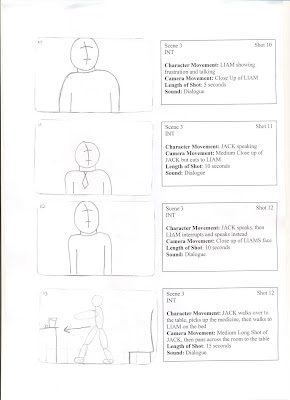Location Recce:
Technical Recce: As the room we are using is of a small size there were no reastrictions ion shooting. for the look we wanted we had to add a few features into the room such as a table and a chair, as these were our largest props.
Risk Assessment:
If there was a fire there are 3 exits out of the room, one is the main entrance, the second into a second room and there is a third door leading into the 3rd room.
There is a table in the room and somebody may bump into them causing themselves injury, to avoid this, all of the crew need to be warned about the hazard and act sensibly at all times.
The chairs could be tripped over if they are not tucked away properly; all chairs need to be moved out of the way once they have been used.
Power supplies could be a risk if they are left on and touched. All power supplies need to be noted and all the back stage crew and actors need to have a wear of where they are.
We need a risk assessment so that we can see what risks there are during the filming and how we can avoid any injuries.
Shooting Schedule: Our shooting was organised in a lesson and we decided as a group that we would shot on tuesday in our second media lesson. The location was organised previously and we started filimg at 11 o'clock. We shot the scene and we finished filming at 1:30, the shooting was successful.
Mise-en-Scene:
Lighting:
In the TC block corridor there is a main door which will provide manmade natural sunlight, this will brighten the room enough to make it look cell like.
Props:
There will be one table acting as a bed for the patient with a duvet over the top, we will also need a black curtain to cover over the door that comes into shot.
Costume:
LIAM- Lab coat backwards to look like patient.
JACK- White lab coat, with black trousers.
With these costumes it fits the theme of the characters and more authentic.
Hair and Make-Up:
LIAM - Hair will be messy, face will look tired.
JACK - hair will be formal, maybe glasses to emphasize character.
LIAMS hair will be messy to make the audience see that he is a troubled person. We have made JACK wear a lab coat to show his doctor characteristics.
Set Design:
The room is spacious and sets a good atmosphere for a cell. It has 2 door windows at the ront of the room with a dark carpet. There is one light on the roof which will provide needed light.
Character Movement:
At the start of the filming JACK walks down the path and then through the wooden doors, he walks to the chair and sits down. LIAM is already sitting in his bed, as the dialogue continues both characters remain in the same posistion. At the end of the dialogue JACK stands up and walks towards LIAM in order to offer him medicine, LIAM bangs JACK's hand and drops the object, JACK picks the tablets up off the floor and walks out of the room.

























